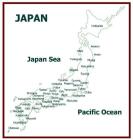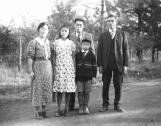2
Toyokichi Taiji was born in 1892 in Tanami-mura, Wakayama-ken, Japan. His wife, Oei (Takenaka) Taiji, also of Tanami-Mura, was born in 1891. Toyokichi immigrated to Canada in 1919, joining Oei's father and brother in Alberta where he worked growing grain, cattle farming, and on a threshing crew. In 1923, Oei joined Toyokichi in Alberta, leaving their young son in the care of his grandparents in Japan. The winter of 1923-1924 was extremely cold, and after weighing the situation Toyokichi and Oei moved to Vancouver. Later in 1924, they moved to Okanagan Centre to work for the Okanagan Valley Land Company.4
The Taiji's had three children, their son Kiyoji, who remained in Japan until the age of twelve, daughter Michi, and son, Susumu 'Sus', both born at the Japanese workers' camp.After many years of working for the Okanagan Valley Land Company, Toyokichi first rented and then purchased his own orchard and home in Winfield. The Taijis were very active in the community and Mr. Taiji became the community liason for the Koyukai Friends and Fellowship Association, working to improve the lives of the Japanese people in the area. Toyokichi and Oei's love of nature led to their involvement in the Aobakai Haiku Club.
5
The Koyukai Association1920s
Rainbow Ranche, Okanagan Centre, BC
 Credits:
Credits:Lake Country Museum, Image #2007.010.001
6
Toyokichi and Oei Taiji, remembered by their son Susumu Credits:
Credits:Sus Taiji
Lake Country Museum, interview 2011
7
In Japan, Toyokichi Taiji worked as a carpenter. When he immigrated to Canada he brought his carpenter's saw with him. Mr. Taiji, as a skilled carpenter, helped build many of the homes in the community.The Japanese saw 'nokogiri' is a type of saw used in carpentry that cuts on the pull stroke, unlike western-style saws which cut on the push stroke. The nokogiri also has a thinner blade, allowing it to cut more precisely with a narrower cut. The saw blade was forged in Japan by a steelsmith in the late 1800s, the handle is believed to have been carved by either Toyokichi or his father.
9
The Aobakai Club usually met at the Rainbow Ranche, and from there explored the area's natural sights, often picnicking outdoors. The members took turns composing haiku, a form of Japanese poetry composed of seventeen syllables.Yellow flowers bow
To soaring pines everywhere
Springtime's beauty shines
(author unknown)
The following photo of the Aobakai includes Toyokichi Taiji on the far left (leaning on his arm) with Oei beside him (front row). Children Susumu and Michi are pictured on the right. Susumu is holding a hat.
10
The Haiku ClubLate 1930s
Rainbow Ranche, Okanagan Centre, BC
 Credits:
Credits:Lake Country Museum, Image #2007.010.007
11
Each spring, the Aobakai celebrated 'Hanami', the blossom festival.12
Aobakai PicnicMay 1938
Rainbow Ranche, Okanagan Centre, BC
 Credits:
Credits:Sakuji and Sachiyo (Kobayashi) Koyama collection
13
Tokokichi and Oei Taiji outside their home in Winfield, 1950s.Both Toyokichi and Oei passed away in 1981, at the ages of 88 and 89 respectively. Their two younger children, Susumu and Michi still live in the community. Their eldest son Kiyoji returned to Japan.



